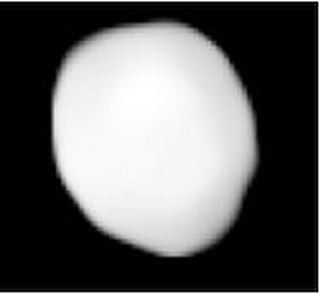
Europa is the 6th-largest asteroid in the asteroid belt, having a diameter of over 300 km, though it is not correspondingly massive. It is not round but is shaped like an ellipsoid of approximately 380×330×250 km. It was discovered on 4 February 1858, by Hermann Goldschmidt from his balcony in Paris. It is named after Europa, one of Zeus's conquests in Greek mythology, a name it shares with Jupiter's moon Europa.
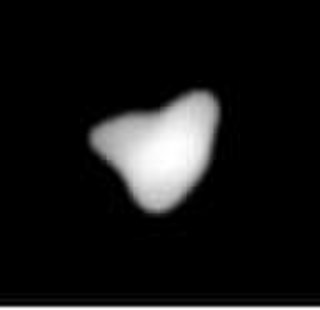
Urania is a large main-belt asteroid that was discovered by English astronomer John Russell Hind on July 22, 1854. It was his last asteroid discovery. This object is named after Urania, the Greek Muse of astronomy. Initial orbital elements for 30 Urania were published by Wilhelm Günther, an assistant at Breslau Observatory. It is orbiting the Sun with a period of 3.64 years and is spinning on its axis once every 13.7 hours.

Pomona is a stony main-belt asteroid that is 81 kilometres (50 mi) in diameter. It was discovered by German-French astronomer Hermann Mayer Salomon Goldschmidt on October 26, 1854, and is named after Pōmōna, the Roman goddess of fruit trees.
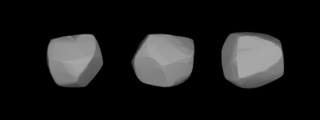
Fides is a large main-belt asteroid. It was discovered by German astronomer Karl Theodor Robert Luther on October 5, 1855, and named after Fides, the Roman goddess of loyalty. Fides was the last of the main-belt asteroids to be assigned an iconic symbol. 37 Fides is also a S-type asteroid in the Tholen classification system.

Harmonia is a large main-belt asteroid. It was discovered by German-French astronomer Hermann Goldschmidt on March 31, 1856, and named after Harmonia, the Greek goddess of harmony. The name was chosen to mark the end of the Crimean War.
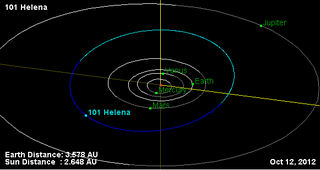
Helena is a large, rocky main-belt asteroid. It was discovered by Canadian-American astronomer J. C. Watson on August 15, 1868, and was named after Helen of Troy in Greek mythology.
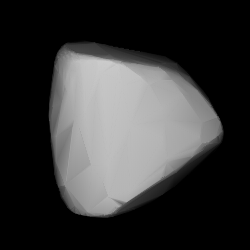
Hera is a moderately large main-belt asteroid with an orbital period of 4.44 years. It was discovered by Canadian-American astronomer James Craig Watson on September 7, 1868, and named after Hera, queen and fifth in power of the Olympian gods in Greek mythology. This is a stony S-type asteroid with a silicate surface composition.

Lydia is a large belt asteroid with an M-type spectrum, and thus may be metallic in composition, consisting primarily of nickel-iron. It was discovered by French astronomer Alphonse Borrelly on 19 April 1870 and was named for Lydia, the Asia Minor country populated by Phrygians. The Lydia family of asteroids is named after it.

Ate is a main-belt asteroid discovered by the German-American astronomer C. H. F. Peters on August 14, 1870, and named after Ate, the goddess of mischief and destruction in Greek mythology. In the Tholen classification system, it is categorized as a carbonaceous C-type asteroid, while the Bus asteroid taxonomy system lists it as an Ch asteroid.

Kassandra is a large and dark main-belt asteroid. It belongs to the rare class T. It was discovered by C. H. F. Peters on July 23, 1871, and is named after Cassandra, the prophetess in the tales of the Trojan War. The asteroid is featured in the 2009 film Meteor, in which it is split in two by a comet, and set on a collision course with Earth.
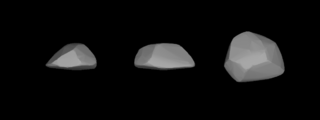
Althaea is a main-belt asteroid that was discovered by Canadian-American astronomer J. C. Watson on April 3, 1872, and named after Althaea, the mother of Meleager in Greek mythology. Two occultations by Althaea were observed in 2002, only a month apart.

Nemesis is a large 180 km main-belt asteroid, of carbonaceous composition. It rotates rather slowly, taking about 78 hours to complete one rotation. Nemesis is the largest member of the Nemesian asteroid family bearing its name. It was discovered by J. C. Watson on 25 November 1872, and named after Nemesis, the goddess of retribution in Greek mythology.

Cyrene, minor planet designation 133 Cyrene, is a fairly large and very bright main-belt asteroid that was discovered by J. C. Watson on 16 August 1873 in Ann Arbor, Michigan, and named after Cyrene, a nymph, daughter of king Hypseus and beloved of Apollo in Greek mythology. It is classified as an S-type asteroid based upon its spectrum. It is listed as a member of the Hecuba group of asteroids that orbit near the 2:1 mean-motion resonance with Jupiter.

Eucharis is a large, slowly rotating main-belt asteroid that was discovered by French astronomer Pablo Cottenot on February 2, 1878, from Marseille Observatory. It was his only asteroid discovery. This object was named after Eucharis, a nymph from the 17th-century novel Les Aventures de Télémaque.
Oppavia is a sizeable Main belt asteroid. It was discovered by Austrian astronomer Johann Palisa on 31 March 1886 in Vienna and was named after Opava, a town in the Czech Republic, then part of Austria-Hungary, where Palisa was born. It is orbiting the Sun at a distance of 2.75 AU with an orbital eccentricity (ovalness) of 0.077 and a period of 4.55 yr. The orbital plane is inclined by an angle of 9.47° to the plane of the ecliptic.

Elvira is a typical main belt asteroid and is a member of the Koronis asteroid family. It was discovered by Auguste Charlois on 3 May 1888 in Nice. (277) Elvira is possibly named for a character in Alphonse de Lamartine's Méditations poétiques (1820) and Harmonies poétiques et religieuses (1830).

Devosa is a large Main belt asteroid. It was discovered by Auguste Charlois on 22 September 1892 in Nice. The asteroid is orbiting the Sun at a distance of 2.38 AU with a period of 3.68 years and an eccentricity (ovalness) of 0.14. These orbital elements are similar to that of the large asteroid 4 Vesta. The orbital plane of 337 Devosa is tilted at an angle of 7.85° to the plane of the ecliptic.

Dodona is a large Main belt asteroid that was discovered by the French astronomer Auguste Charlois on 29 January 1894 in Nice. It is classified as an M-type asteroid.

Vienna is a typical Main belt asteroid. It was discovered by French astronomer Auguste Charlois on 19 December 1894 in Nice, and was most likely named after the city of Vienna, Austria. This object is orbiting the Sun at a distance of 2.64 AU with an orbital eccentricity (ovalness) of 0.246 and a period of 4.28 yr. The orbital plane is inclined at an angle of 12.85° to the ecliptic.

694 Ekard is a minor planet orbiting the Sun that was discovered by American astronomer Joel Hastings Metcalf on November 7, 1909. The asteroid's name comes from the reverse spelling of Drake University in Des Moines, Iowa, where Seth Barnes Nicholson and his wife calculated its orbit.



















